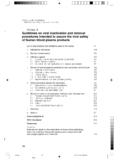Transcription of PROCESSING THE RADIOGRAPH - Columbia University
1 11 PROCESSING THE RADIOGRAPH . Neill Serman. Sept. 2000 W + P. Chapter 6 THE STAGES IN THE PRODUCTION OF THE RADIOGRAPH Many dentists who utilize manual PROCESSING , intentionally over expose patients and under process the RADIOGRAPH in an attempt to save time resulting in radiographs that are inferior in diagnostic quality because of incomplete developing. When an X-ray film has been exposed, it must be processed in order to produce a permanent visible radiographic image that can be kept without deterioration for a number of years. PROCESSING transforms the latent image into a visible image. The term for the several procedures that collectively produce the visible, permanent image is PROCESSING and consists of developing, rinsing, fixing, washing and drying procedures 1.
2 Exposure - Latent image created. 2. Development - Converts latent image to black metallic silver. 3. Wash [stop bath] - Removes excess developer. 4. Fixing and Hardening - Dissolves out unexposed silver halide crystals. 5. Washing - Removes products of PROCESSING . 6. Dry - Removes water. For manual PROCESSING a floating thermometer, a timer and the time -temperature chart are essential. 1. LATENT IMAGE FORMATION. The latent (invisible) image formation is the ionization of the exposed silver bromide crystals (by photon energy that emerges from the patient) occurring in the emulsion layer before PROCESSING occurs.
3 The primary interaction with the bromide crystals is by Compton and photoelectric interactions, thereby knocking out electrons. Thus, a physical change occurs when the RADIOGRAPH is exposed. When X-ray photons [or light photons] strike the silver bromide crystals in the emulsion, minute amounts of silver ions are formed on the surface of the crystal and bromine is liberated and is absorbed by the gelatin. Crystals are purposely constructed with electron traps (sensitivity specks) consisting of sulfur impurities but also because of the addition of silver iodide. Electrons are trapped by the sulfur in the sensitivity specks giving it a negative charge. When this situation is created a latent image is produced in the film emulsion.
4 AgBr + X-ray photons = Ag+ + Br- Silver bromide Silver ions + Bromine ions The latent image is formed by deposits of free (ionized) silver ions that cannot be seen or detected by any physical test devised as yet. It remains in the emulsion of the X-ray film until it is changed into a visible silver image by chemical PROCESSING procedures. 22 The free electrons move through the crystal until they are attracted to a sensitivity site where they become trapped and impart a negative charge to the site. 2. PROCESSING THE EXPOSED FILM Exposed radiographs that contain a latent image should be processed as soon as possible as they are more sensitive to energy.
5 Film packets are only to be opened in the darkroom or under safe-light conditions. [ in a daylight loader] The developer solution is the first solution into which the films are placed. The developer chemically reduces the energized ionized silver bromide crystals by donating electrons, removing the halides and precipitating metallic silver in the emulsion layer. The negative charge attracts positively charged free silver ions and is reduced to black metallic atoms. This precipitation corresponds to the black (radiolucent) areas on the RADIOGRAPH . The concentration of the developer slowly weakens due to the number of films processed, [a chemical reaction] and with time by oxidation of the developer by exposure to air.
6 Traditionally, the developer tank is placed on the left side of the other chemicals solutions 3. RINSING PROCESS / STOP BATH (WASHING) When the film is removed from the developer the gelatin emulsion is soft and swollen and contains chemicals which are removed by placing the film in a water bath. By rinsing the film in the water the soluble chemicals are removed, the development reaction is stopped, and the alkalinity of the residual developer is reduced. The unexposed silver halide crystals are not water soluble and will not be washed away. The film should be rinsed for 10-15 seconds in a bath of fresh, running water. The temperature of the water must be as close as possible to the temperature of the developer and fixer to avoid reticulation - uneven expansion and contractions of the emulsion layer.
7 If this step were omitted, the alkaline developer retained by the film would soon neutralize the acid of the fixer. The fixing and hardening action of the fixer would be impaired and as a result, brown stains will be produced on the RADIOGRAPH within a few weeks. Because the emulsion layer (gelatin) is soft when wet, the film scratches easily. Safe-light conditions must be maintained when transferring the film from the developer to the wash tank and then to the fixing tank to avoid fogging. For automatic PROCESSING there are "squeegy" rollers that remove the chemicals and thus the film goes from the developer solution straight into the fixer. 4. FIXING. The acidic fixing solution removes the unexposed and undeveloped silver bromide crystals from the film emulsion and re-hardens the emulsion that has softened during the development process.
8 For manual PROCESSING , if the film is placed in the developer solution for X amount of time it should be placed in the fixer for 2X and in the final rinse for 3X 33amount of time. "X" is determined by the time-temperature chart. The ideal time to process radiographs in the developer is 680 F for 5 minutes. However, films may be removed from the fixing solution after five minutes for viewing only in cases of emergency - this procedure is known as wet reading \ viewing. The film must then be placed back in the fixer. If these unwanted silver bromide crystals are not removed, the resultant film will discolor after a few months. If the film is only partially fixed the film will turn brown in color with age.
9 The gelatin protective coating is hardened by the potassium alum so the film will resist abrasion / scratching 5. FINAL WASH. The purpose of the final wash is to remove residual fixer chemicals acid, thiosulfate and silver salts from the film. Insufficient washing results in the film turning brown as all the chemicals have not been washed away. If the temperature difference between developer and / OR fixer and water exceeds 15 F, there is a possibility of unequal swelling and shrinkage of the emulsion layer, commonly referred to as reticulation. Also, prolonged washing tends to make the emulsion soft, and it then scratches more easily. 6. DRYING. In most offices, films are dried merely by hanging them on a rack in the darkroom above a drip tray designed to catch the run-off excess water.
10 Others use a fan to dry the film. The fan should not blow directly on the films. Cabinet dryers are available which are equipped with a fan and heating elements Wet films are subject to damage from scratching and abrasion if not handled properly. If there is dust in the air, dirt will become easily embedded within the emulsion. Do not remove wet radiographs from their hangers until they are completely dry In most darkrooms the developer will be in the left-hand tank as you face the tank, the water bath in the center and the fixing solution in the right-hand tank. The developer can be identified by its soapy feel, (alkali) the fixer by its vinegary odor when fresh and acid taste An area of less density, say the pulp, will allow greater penetration of X-rays; therefore more X rays will reach that part of the film.













